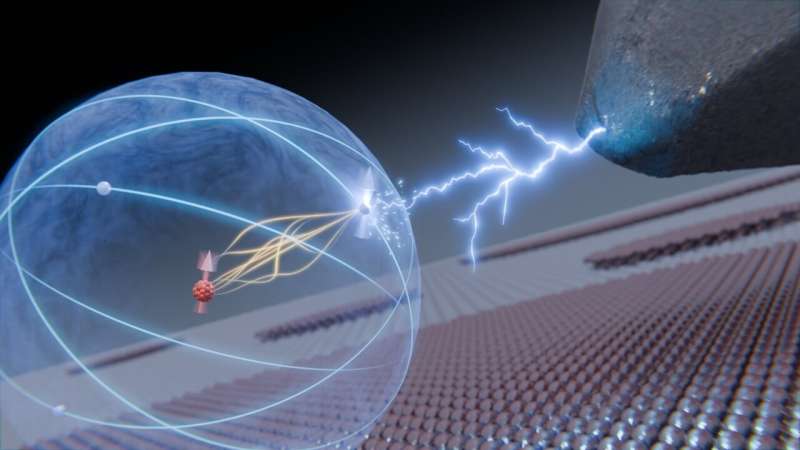
Researchers from Delft University of Technology in The Netherlands have been able to initiate a controlled movement in the very heart of an atom. They cause the atomic nucleus to interact with one of the electrons in the outermost shells of the atom. This electron can be manipulated and read through the needle of a scanning tunneling microscope. The research, published in Communication in Nature now, offers prospects for storing quantum information inside the nucleus, where it is safe from external disturbances. Credit: TU Delft
Researchers from Delft University of Technology in The Netherlands have been able to initiate a controlled movement in the very heart of an atom. They cause the atomic nucleus to interact with one of the electrons in the outermost shells of the atom. This electron can be manipulated and read through the needle of a scanning tunneling microscope.
The research, published in Communication in Natureoffers prospects for storing quantum information inside the nucleus, where it is safe from external disturbances.
For several weeks, the researchers studied a single titanium atom. “A Ti-47 atom, to be precise,” said research leader Sander Otte. “It has one neutron less than the naturally abundant Ti-48, making the nucleus slightly magnetic.”
This magnetism, “spin” in quantum language, can be seen as a kind of compass needle that can point in different directions. The orientation of the spin at a given time constitutes a piece of quantum information.
The nucleus of an atom floats inside a relatively giant void away from the orbiting electrons, oblivious to its surroundings. But there is one exception: because of the extremely weak “hyperfine interaction,” the nuclear spin can be influenced by the spin of one of the electrons.
“Easier said than done,” said Lukas Veldman, who recently defended his Ph.D. research dissertation with honors. “The hyperfine interaction is so weak that it is only effective in a very small, precisely focused magnetic field.”
Once all the experimental conditions were met, the researchers used a voltage pulse to push the electron spin out of equilibrium, after which both spins oscillated together for a fraction of a microsecond. “Exactly how Schrödinger predicted,” Veldman said.
Alongside the experiments, he performed calculations that reproduced the observed fluctuations surprisingly well. The strong agreement between observations and predictions shows that no information at all is lost during the interaction between the electron and the nucleus.
The excellent shielding from the environment makes the nuclear spin a viable candidate for holding quantum information. Current research may bring that application one step closer. But that’s not what’s driving the researchers.
Otte says, “This experiment gives people influence over the state of matter on a small scale.
More information:
Lukas M. Veldman et al, Coherent spin dynamics between electron and nucleus within an atom, Communication in Nature (2024). DOI: 10.1038/s41467-024-52270-0
Provided by Delft University of Technology
Quote: Quantum researchers induce controlled ‘wobble’ in an atom’s nucleus (2024, September 12) retrieved September 12, 2024 from https://phys.org/news/2024-09-quantum-nucleus -atom.html
This document is subject to copyright. Except for any fair dealing for the purpose of private study or research, no part may be reproduced without written permission. The content is provided for informational purposes only.
#Quantum #researchers #controlled #wobble #nucleus #atom